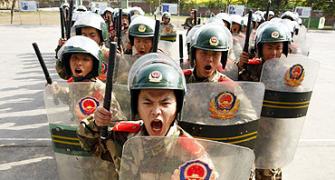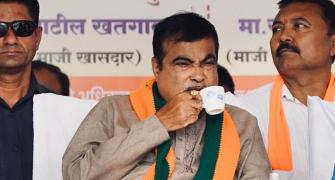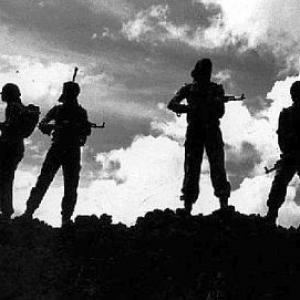 If Indian soldiers became known worldwide for their professionalism as fearless fighters in many campaigns, including World Wars I and II, from India's Independence onwards, their natural instinct and expertise for humanitarian work got established and acknowledged by the United Nations Organisation, since their first assignment in Korea, where, as part of the Custodian Force, they did the task commendably.
If Indian soldiers became known worldwide for their professionalism as fearless fighters in many campaigns, including World Wars I and II, from India's Independence onwards, their natural instinct and expertise for humanitarian work got established and acknowledged by the United Nations Organisation, since their first assignment in Korea, where, as part of the Custodian Force, they did the task commendably.
The euphoria of attaining independence was short-lived, as the consequences of partition soon began to unfold. The acid test of the then recently divided Indian Army's humanitarian and impartial character came, when the cross-movement of refugees between India and the newly created Pakistan led to mistrust and mindless communal violence.
Those who were fortunate to survive and reach their destination would never forget the sense of safety they felt when escorted by even a handful of army personnel. Besides protection for refugee columns, the army also provided medical cover at points along the refugee routes.
The Military Evacuation Organisation was formed to organise the safe movement of civilian refugees, and a major refugee camp was set up at Kurukshetra under Brigadier Nathu Singh, who years later retired as General Officer Commanding-in-chief of the Eastern Command.
The MEO did a yeoman service. Interacting with this writer, Brigadier S S Malik, an instructor at the Defence Service Staff College at Quetta in 1947, recalled an interesting incident when the time came to break up the course and return to India.
Malik was in charge of a special train to bring back military personnel from Quetta to Ambala. Many civilians were desperate to reach India. Ignoring orders not to take any civilians on the train, he took in as many as possible, with the result that two-thirds of the packed train comprised civilians.
Only one light machine gun and 12 rifles were allowed on board. All these were manned by the staff college student officers, with orders to shoot from the windows if attacked by mobs.
Interestingly, it was Malik's old friend, Major Yahya Khan (later General and the second dictator President of Pakistan), who warned him of a plan to sabotage the train.
"He was not in favour of Pakistan," Malik said. The train finally chugged out of Quetta and during the tense three-day journey before it reached Hindumalkot (near Fazilka), Pakistani detachments en route took potshots at it. Fortunately, no one was hurt. At Hindumalkot, the change of engines, from Pakistani to Indian, took a whole day and finally the train reached Ambala after another day's journey.
One humanitarian field, where the army has been providing large-scale assistance along with the air force, every year since independence, is flood relief.
Some of the most flood-prone regions in the country are Assam and the Manipur valley in the North-East. In 1950 there were massive floods in Assam that saw the army in action on almost war footing, rescuing, feeding and providing medical care to the victims. Rivers like Brahmaputra and the Barak in Assam tend to swell after prolonged heavy rain.
In the event of floods, the army assesses the extent of the damage and dispatches relief columns with all kinds of equipment, including boats, mobile bridges, construction material, medicines and wheeled transport.
Boats are pressed into operation to rescue marooned people, but often soldiers, unmindful of their own safety, take the aged or the infirm piggyback. In many flood relief operations over the past five decades, army personnel have died, while trying to save others.
As rescue actions progress, relief camps are organised, where desalination plants are set up for providing drinking water and food is distributed. Breached river embankments are repaired and, at times, when portion of bridges get damaged or destroyed, they are reconstructed.
Personnel of signal units and electrical and mechanical engineers assist their civilian counterparts in re-erecting telephone poles and lines and repairing military military and civilian vehicles.
Usually the army is requisitioned by the local civil authority, but there have been times when it has voluntarily moved in anticipation of a requisition or on seeing an area in close proximity getting inundated.
There have been instances when the barracks or houses of soldiers fighting floods are flooded in their absence.
Major flood-relief operations mounted in recent years, apart from those in Assam and Manipur, have been in Jammu and Kashmir, Haryana, Punjab, Delhi, Uttar Pradesh and Mumbai, which faced what was probably the worst of floods ever.
Another natural calamity that requires more or less the same kind of action is cyclones that ravage the eastern coastline stretching from Tamil Nadu to West Bengal. The greatest of all water borne disasters was the tsunami, in which the army rendered assistance within the shores and, the Indian Navy made a mark globally by not only reacting on a wide scale for assistance on the country's coastline, but also to three other countries: Indonesia, Sri Lanka and Male.
Earthquakes have also brought the army out, some of the severest being in Koyna and Latur (Maharashtra), Garhwal (Uttar Pradesh) and Gujarat.
In recent years, the new curse of manmade disasters is terrorist bombings in crowded areas, trains or buses, as well as train accidents. In most such instances, the fastest to react are the soldiers who survive the explosion or accident. They begin helping out, often setting examples to others around and rallying them into the effort.
On October 1, 1997 Havildar Jagat Singh of the 104th Engineer Regiment was traveling to his hometown in Punjab on the Frontier Mail. Soon after the train left Delhi, there was explosion in some coaches behind the one in which Singh was traveling
When the train reached Ghaziabad station, panicky passengers started rushing out. That was when Singh saw a polythene-covered packet beneath a berth. Lifting it carefully, he was about to throw it out, when it exploded, severing his right hand from the wrist and three fingers on his left hand.
"The Indian Army has a long record of disaster relief. Are they trained specially for this?" asked Andrew Whitehead, BBC's South Asia correspondent in 1993.
The answer is that no disaster relief training as such is imparted to army personnel. For them, this task is merely another drill or procedure in which, as soon as they come to know the nature and extent of the disaster, they react quickly, taking with them the appropriate supplies and equipment.
Their agrarian roots, conditioning, discipline and pride as soldiers make them render relief to their countrymen instinctively.
Counter-insurgency, anti-terrorism, externally-supported low intensity conflict and United Nations peacekeeping operations have one major task common to them -- civic action. In all cases, large-scale multi-faceted assistance programs are launched to ameliorate the lot of civilians.
This involves a wide gamut of actions like repair and construction of buildings, roads, railway tracks and bridges, schools, hospitals, relief camps and delivery of food or rations.
Medical and veterinary care also form an important part of civic-action projects. This involves not only setting up clinics but also pressing into service roving mobile detachments in far-flung and not easily accessible areas, almost always with the threat of attack by hostile elements.
Yet another task that has often been performed by Indian Army units in Jammu & Kashmir and during UN peacekeeping operations is of running refugee camps, schools and orphanages.
In India's North-Eastern region, there as many areas where developmental assistance has been provided by the Army or its smaller sibling, the Assam Rifles. Particularly in interior areas of Nagaland, Manipur, Arunachal Pradesh and Assam, the Army has a record of half a century of developmental projects that include almost all the facets mentioned earlier.
Arunachal Pradesh is one state where there are places named after Army personnel, as they were the first outsiders to reach there.
A very important aspect of development in the North-Eastern region and J&K is trailblazing by the Border Road Organisation, which has a record of building wide, good-quality and well maintained roads, challenging bridges and tunnels, airfields and many other infrastructural assets.
BRO has one project called Dantak, headquartered in Bhutan, where it has created most of the infrastructure of roads and various installations that have helped that mountain kingdom to develop.
In J&K, where the BRO began project Beacon decades ago, construction of new roads reduced the travelling time to almost half of that the old roads. There are so many areas in this state, where the terrain is indeed taxing and where the Army is a veritable backbone.
There are places like the Nubra Valley and Ladakh where the bonds between the Army and the local population are very strong as most of the development work there has been done by the Army. The people of Nubra have a tradition of assisting the Army as they are fiercely patriotic to India. Late Colonel Rinchen, one of the Army's highest decorated soldiers who died a few years ago, first fought with the Army as a 16 year-old local volunteer, whose role was crucial in wresting Nubra from Pakistan.
Since the late 1980s, when Pakistan began its proxy war with export of terrorism in Kashmir (and thereafter, all-India), the Army has not only battled anti-national forces (on Indian soil), but simultaneously undertaken schemes to ameliorate the condition of a people battered by terrorist violence. Operation 'Sadbhavna', which began alongside the counter-terrorism operation in J&K, since 1998, was extended considerably after November 2003.
In 1996, when devotees trudged along the high slopes to Mount Amarnath for an annual pilgrimage despite a threat by terrorists, the weather took a nasty turn. A sudden cold wave shower killed a number of ill-clad pilgrims. The same troops heavily committed in counter-terrorism operations, reacted swiftly for relief and rescue.
There is much more on Indian Army's humanitarian contribution than the space available, but some requests or wishes, heard often from UN mission commanders of other countries, worth mentioning are "they are good peacekeepers and peacemakers Give me an Indian battalion I wish all my battalions were from the Indian Army Get me more Indian officers "
Image: Indian Army personnel rescuing flood victims in Assam







